Centennial of Oldest Black Collegiate Paper
. . . Editors’ Shared Experience: Covering Protests
Jury Backs Coach Falsely Reported to Have Used N-Word
$5 Million to Preserve Radio Material at HBCUs
Media Begin Marking Black History Month
Press Groups Want Rwanda Death Investigated
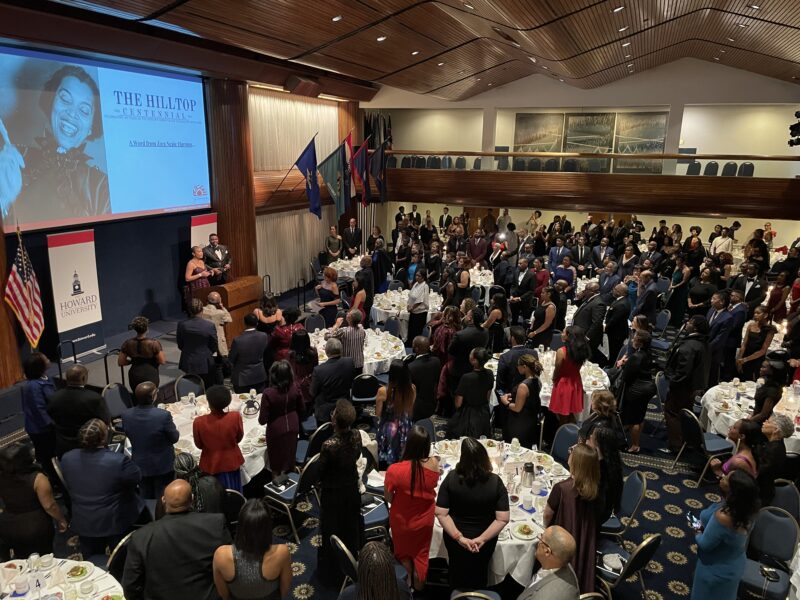
Centennial of Oldest Black Collegiate Paper
By Isaiah Jerome Lewis Poole
Isabel Wilkerson, a Pulitzer Prize-winning journalist and best-selling author of critically acclaimed books on race in America — including “Caste: The Origin of Our Discontents,” the inspiration for the current movie “Origins” — paid tribute Saturday to where she got her start in journalism — Howard University’s student newspaper, The Hilltop.
The occasion was the centennial celebration at Washington’s National Press Club of the founding of the newspaper, which was launched by two former Howard students, Zora Neale Hurston, who was soon to become a central figure in the Harlem Renaissance, and Eugene King. Hurston’s rise from Hilltop co-founder to literary icon set the stage for the paper’s long history of incubating generations of leaders in journalism and other fields. Wilkerson is just one example.
The publication touts itself as the nation’s oldest Black collegiate newspaper.
The elegant Press Club reception and banquet was part of a weekend that included a Friday evening “fireside chat” with former Hilltop editors at D.C.’s Martin Luther King Jr. Library, and a Call to Chapel service that followed a Hilltop Centennial Sunday Brunch in the Blackburn Center’s Hilltop Lounge.
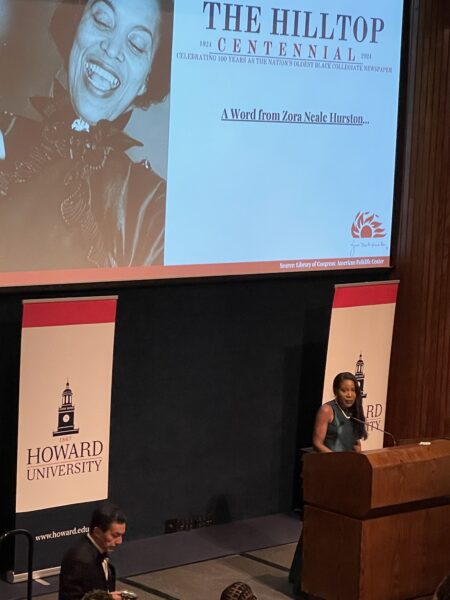
Among those saluted from the stage were Michelle Miller of CBS News; Vicki Mabrey of ABC News; Portia Bruner, host of the nationally distributed television talk show “Portia,” and Monica Lewis, Howard University’s assistant vice president of strategic communications.
Emcee Derricke Dennis, who was runner-up for Hilltop editor-in-chief in 1994-1995, is an ABC News correspondent. Also getting a shout-out from the stage was Cathy Hughes, who began her radio career at campus radio station WHUR-FM and launched a career as a leading Black broadcast media owner. The School of Communications is now named for her.
“You represent some of the best writers, reporters and communications minds in the world,” said Howard University President Ben Vinson III. “And just seeing you interact; from the moment that I stepped foot on this floor, I have seen incredible camaraderie. Incredible spirit, people who haven’t seen each other in years reconnecting, and just seeing the careers that, oh my goodness, this room is exploding in talent. And the connections that you’re making with our current students, it just brings it back home.”
Wilkerson said, “For me, the history and the legacy of The Hilltop was one of the main reasons I came to Howard.”
One of the first things she did when she arrived, before school started, was to go unannounced to the Fourth Street NW rowhouse that served as The Hilltop’s newsroom. “They were busy,” she said, putting out the first edition of the paper for that school year. An editor waved her off toward the second floor, where the paper’s features editor was also busy. “So she welcomed me with a story assignment. I hadn’t counted on that. So I ended up with a story in the first edition of the paper before I even started as a freshman.”
That started an odyssey during which “grades suffered, class assignments got delayed, we forwent sleep. We did not care. We loved it. It became a part of our being. When people asked me if I pledged, I say, ‘I guess. I pledged Hilltop.’”
Wilkerson recalled the days of laying out the paper (“Every single page. Every. Single. Page”) by pasting strips of what was then called “cold type” on galleys. “Each editor stood at their section with white cartons of chicken fried rice from the Chinese restaurant,” and when the galleys were completed late at night and the paper was on the presses, they celebrated at a nearby International House of Pancakes.
WJLA-TV, Washington’s ABC affiliate, was one of several media outlets that noted The Hilltop’s centennial. The first issue of the newspaper was published on Jan. 22, 1924. (Credit: YouTube)
“It was a puzzle that was assembled every week, a work of art that was conceived like a family member that we brought to life every Thursday night in the era that I was part of. We took a break, caught our breath, and then started all over again from scratch the next week,” she said.
“The Hilltop is and always has been much more than a newspaper. It is the legendary beating heart of life at Howard University and has connected every person on campus for generations,” Wilkerson said. She also called its founding “a bold and radical act” by people whose ancestors not that long previously were in many cases “forbidden the basic right to learn to read and write.
“And so here they were, a little more than 50 years after emancipation. And they were stepping outside of that assignment. They were doing what the ancestors had been forbidden to do. And they were showing the world what was possible. . . . And what they were doing was that they ended up defying those roles at a time of Jim Crow in a redlined and segregated city in Washington, D.C., and to have the audacity to start a newspaper of their own.”
Given today’s threats to democracy and to such policies as affirmative action, designed to undo the effects of America’s racial past, “the work of the originators of this paper” and the champions of human and civil rights who have walked the campus over the years remains to be done.
“I want to exhort all of us, all who hold Howard dear, who cherish this legendary newspaper, who care about freedom of the press and democracy to do all that we can in our spheres of influence to protect and uphold it, to protect and uphold the students who are working so hard on this, to protect and uphold this paper and the mission of truth-telling and shining a light in the darkest corners, so that this institution can thrive for generations to come.”
Many in the audience gave knowing nods and chuckled when Wilkerson talked about the cartons of fried rice, and the celebratory meals at the International House of Pancakes.
They applauded, they chuckled and laughed at the shared remembrances. At one point, Dennis asked attendees who had worked at the paper to stand when their decade of service was called, starting from the 2020s.
People cheered as the decades wound backward to the 1970s. When Dennis asked to stand those who had been associated with the Hilltop during the 1960s, he also asked people who were descendants of former Hilltop staffers from that decade to do the same. Then he called for a couple of people who were related to Hilltop staff members who worked there in the 1960s and the 1950s to stand, and they, too, were applauded. By the end of that segment, most of the attendees were on their feet.
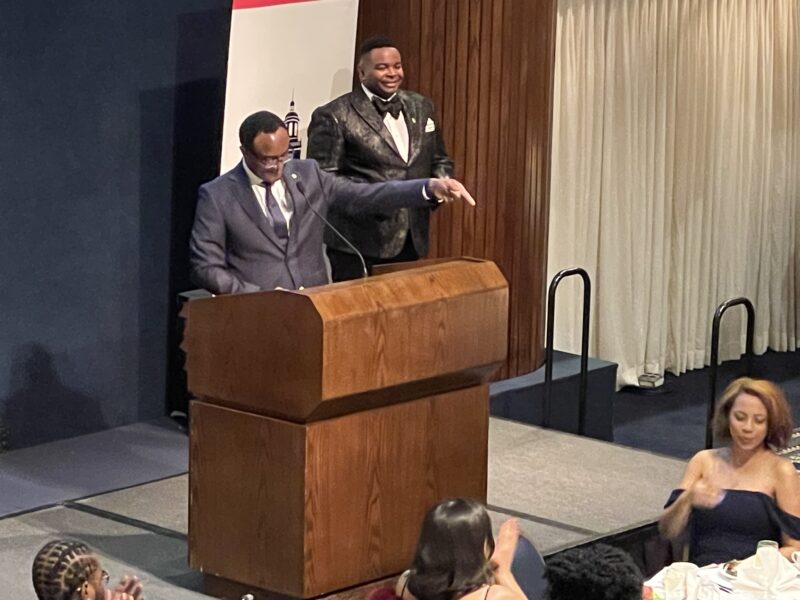
Vinson talked about reading early issues of The Hilltop and being struck by how “the values that Howard holds near and dear were already etched in print in 1924.” The newspaper’s second issue, Feb. 4, 1924, included an article about professors at the university demanding more academic freedom.
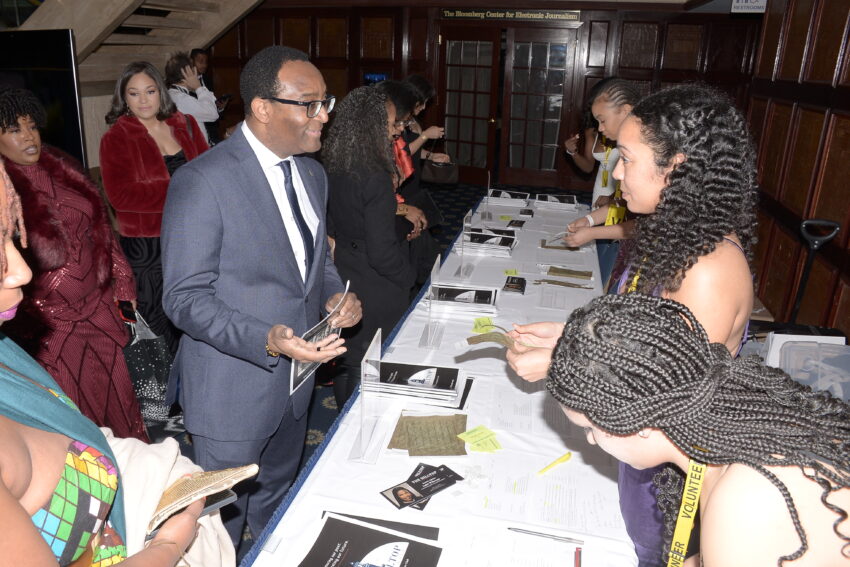
Another story reported that Congress cut the university’s federal funding by $207,500 — close to $3.7 million in today’s dollars and at that time more than half of the university’s federal funding — in retaliation for an article written by Frank Grimke, one of the university’s trustees, entitled, “What Is the Trouble with Christianity Today.”
In that article, Vinson said, Grimke “proceeded to unpack the behavior of white America against Black people, and how that manifested in Christian attitudes.
“So the article, of course, reminds us of the value that when you speak truth, you can be penalized, but that doesn’t diminish the work or the need for it.”
In addition, there were articles about campus life that were routine and timeless, such as one that “chastised the university for having students stand senselessly in long lines to register for classes.”
Vinson added, “Hilltop, you have always been authentic. Always searching for truth. always appreciated our best, always questioned us so that we can do better. As your new president. I’m so thankful for everything that you bring and I look forward to the next century of The Hilltop.”
Isaiah Jerome Lewis Poole was a journalism major at Howard who contributed to The Hilltop in 1974, his junior year.
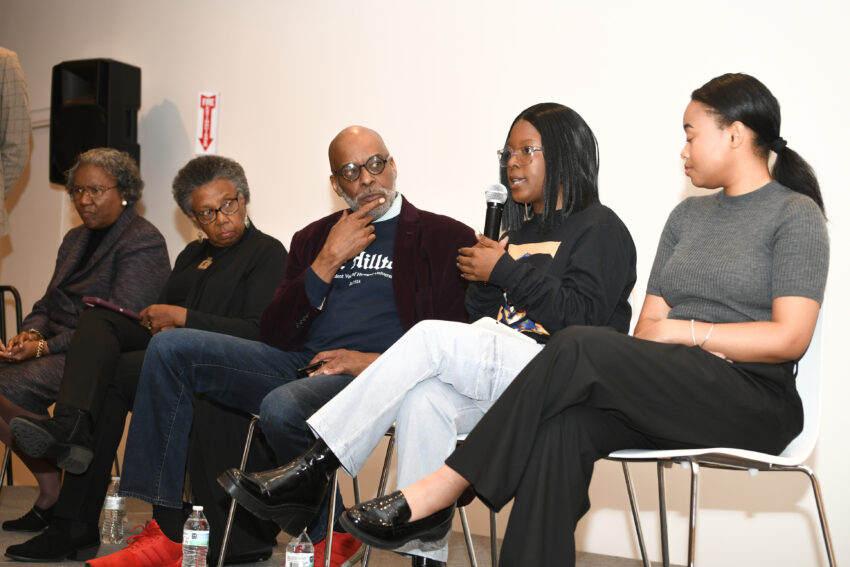
. . . Editors’ Shared Experience: Covering Protests
At the Martin Luther King Jr. Library in Washington Friday, four past Hilltop editors joined current editor-in-chief Jasper Smith in a panel discussion that highlighted pivotal moments in the paper’s history and tensions between The Hilltop, university leadership and the students. About 40 people attended.
Adrienne Manns Israel, editor in 1967-1968, was very much at the center of tensions between an increasingly activist and strident student body and a conservative administration seen as out of step with the emerging Black Power movement.
“The administration tried to get rid of me as editor,” Manns Israel said, because of The Hilltop’s critical coverage of the university leadership under her watch. “We felt that we were countering the status quo,” she said. “It was like they brought us there to be better white people.”
Faculty allies such as the legendary authors Sterling Brown and Arthur P. Davis supported a stronger focus on Black history and the celebration of Black culture, but said they could only do so much. “Our classes were pushing assimilation, and I am not an assimilationist,” she said.
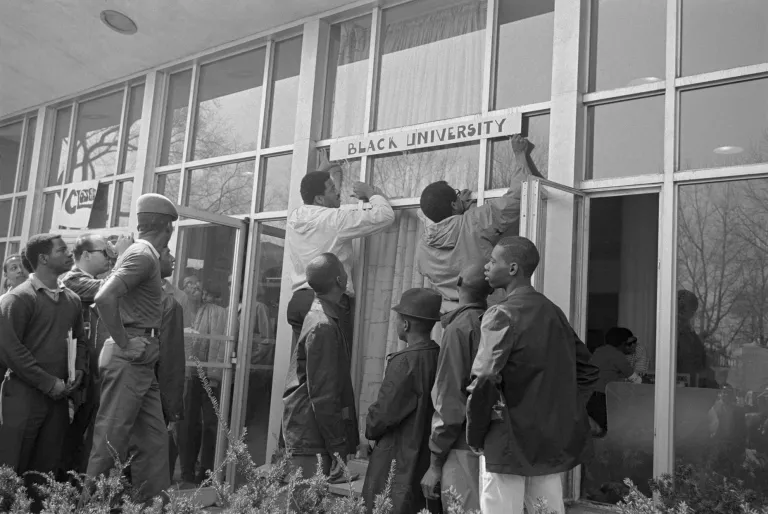
Manns Israel said The Hilltop was the only way for students to get information about these kinds of issues. And for that reason she also fought, at personal risk, for the newspaper’s independence. “We had enough money to run the paper ourselves, and we didn’t have an adviser, either. I had a scholarship and every year I was afraid of losing it.”
In addition to being Hilltop editor, Manns Israel helped with a separate publication, reproduced with a mimeograph machine in the administration building, maintained as a voice for student protesters.
Tensions boiled over in March 1968 when about 1,000 students, Manns Israel among them, took over the administration building in a five-day protest. Their demands included the resignation of then-president James Nabrit. While that demand was not met — instead, Nabrit retired a year later as he had originally planned — the students won changes in the curriculum and the creation of a student judiciary to take part in student disciplinary proceedings.
Pearl Stewart was a writer for The Hilltop under Manns Israel when she covered an earlier Charter Day protest at the university and was detained along with a group of protesters. She also recalled that in 1965, when King gave an address at the university’s Cramton Auditorium, the university refused to give The Hilltop a pass to cover it. Under Editor William Johnson, later the first Black mayor of Rochester, N.Y., The Hilltop ran a story about that denial that prompted the administration to apologize. But, as Stewart said, “by then it was too late.”
By the time Stewart became editor-in-chief for the 1970-71 school year, “we had transformed.” The university that had previously shunned the study of jazz had appointed jazz musician Donald Byrd as chairman of its fine arts department. “We had AfriCOBRA,” the work of Black artists depicting themes of resistance and Afrocentric pride. “The whole purpose of being a Black university did start to happen.” The new university president, James Cheek, was pictured wearing dashikis.
Still, there were to be more clashes between students, the administration and The Hilltop. Alonza Robertson, editor-in-chief in 1989-90, remembered hearing students say of the paper, “Y’all are too passive.”
Robertson said that during his tenure, “we became an irritant to the administration.” He was there in March 1989 when students took over the administration building and successfully demanded the removal from the board of trustees of Republican National Committee chairman Lee Atwater. Atwater orchestrated the “Willie Horton” ads, featuring a menacing-looking Black man who had been released on furlough. In 1988, those ads helped put George H.W. Bush into the White House. Bush defeated Massachusetts Gov. Michael Dukakis, a Democrat whose administration had furloughed Horton.
On Day Four or Five of the protests, as students barricaded themselves in the building and supporters were shuttling food in and out, officials called in a SWAT team. Mayor Marion Barry stood before the police and would not let them storm the building, Robertson recalled.
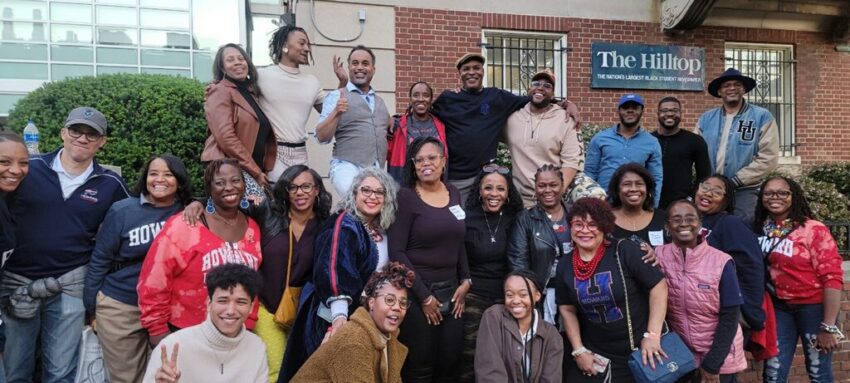
Writing The Hilltop’s lead story on Atwater’s resignation was Keith L. Alexander, who went on to a Pulitzer Prize-winning career at The Washington Post and is now the Hilltop’s adviser. That same front page features an article by Robert J. Vickers, who after graduating from Howard went on to a successful career in journalism and academia. Vickers moderated the panel discussion. Robertson said, “I learned a lot about how to control things that are out of control,” strategies later useful when Black Lives Matter protests materialized.
By the time Jazmin Goodwin became editor-in-chief for the 2017-18 school year, she found herself having to focus on restoring a positive perception of the newspaper among the students. Her tenure at the paper gave her plenty of opportunities, including a nine-day sit-in sparked by allegations of financial mismanagement at the university’s student aid office.
As current editor-in-chief, Smith presides over an operation that is very different from that of most of her predecessors. It has largely abandoned print editions except for four or five special issues a year. Instead, its primary outlet is a multimedia website that features daily news reporting, an active social media presence, and a podcast. But the sense of mission, and historical importance, remains unchanged.
“There’s a sense that this is so much bigger than ourselves, a connection that spans generations,” she said.
— Isaiah Jerome Lewis Poole
- The Hilltop: The Hilltop Centennial Weekend (Feb. 8)
- Bousaina Ibrahim, Washington Informer: Generations of The Hilltop Staff Gather to Celebrate Newspaper’s Centennial (Feb. 6)
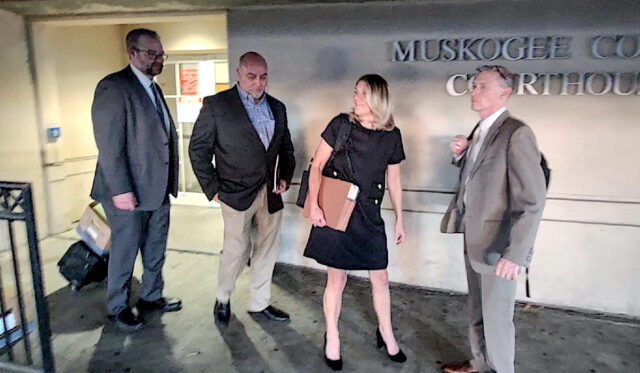
Jury Backs Coach Falsely Reported to Have Used N-Word
An Oklahoma jury has awarded a former high school football coach $5 million in compensatory damages and $20 million in punitive damages after finding he was falsely reported to have use the “n” word to describe Black athletes during a girls’ basketball playoff game, Ronn Rowland reported Monday for CNHI Oklahoma.
“I feel my name will start getting cleared,” an emotional Scott Sapulpa said after the verdict was read. “For my family, that’s what I want.”
Sapulpa had sued Oklahoma Sports Programming Network (OSPN); Gannett Inc., dba The Oklahoman and USA Today newspapers; two reporters who were employed by The Oklahoman; and Matthew Shawn Rowan, OSPN’s owner, after the March 2021 incident.
A jury of seven women and five men on Friday had found in favor of Sapulpa, awarding him damages in a lawsuit for defamation and “intentional infliction of emotional distress,” Rowland reported. “The punitive damages were awarded Monday.”
Sapulpa had been coaching in Hulbert at the time of an on-air “hot mic” incident wherein he was falsely identified by those media as the man making racial slurs during a girls’ basketball playoff game.
“Attorneys representing the defendants declined to comment. But an attorney for Sapulpa said Gannett would likely appeal the verdict,” Rowland continued.
“Rowan and Sapulpa were broadcasting a girls’ basketball state tournament game between Norman High School and Midwest City when the Norman girls knelt on one knee during the national anthem, and Rowan apparently took offense to the gesture.
“During a break before the game started, Rowan is heard making racist comments about the Norman team.
“On the video, and not realizing the microphone was still on, Rowan is heard to refer to the players with racial slurs and cursing. He said, ‘I hope Norman gets their a** kicked,” and then, ‘I hope they lose. C’mon Midwest City. They’re gonna kneel like that? Hell no.’ . . .
“Mike Barkett, one of the attorneys representing Sapulpa, said it shows that faults in The Oklahoman’s story, accusing Sapulpa of uttering of the racial slurs, proved vital to the outcome.
“Court documents indicate the day after the incident, Cameron Jourdan, one of the two reporters for The Oklahoman named as defendants, heard about the incident and concluded Sapulpa had made the comments. The court record also states Jourdan relied on “official sources” who told him Sapulpa was the speaker.
” ‘The discovery that they actually had zero sources supporting naming Scott Sapulpa as the speaker of the racist remarks had a huge impact,” Barkett said. “Then obviously the coverup, lies from that point forward to this jury verdict proved impactful.”
“The record also reports that ‘despite repeatedly being informed that it was not Sapulpa that spewed the racial slurs, The Oklahoman and Jourdan chose to gamble with Sapulpa’s life and ‘doubled down’ on the erroneous story by insisting the reporting had correctly identified Sapulpa as the racist in question.’ . . .”
$5 Million to Preserve Radio Material at HBCUs
“A $5 million grant to a Yellow Springs-based public radio station will fund the preservation of radio material for every Historically Black College or University that has a radio station in the country,” London Bishop reported Jan. 29 for the Dayton Daily News.
“WYSO has been awarded major funding from the Mellon Foundation to support The HBCU Radio Preservation Project, according to WYSO. A collaboration between the WYSO Archives and the Northeast Document Conservation Center (NEDCC), supports radio stations at HBCUs throughout the country in preserving their legacies and cultural heritage, a statement from the station said Monday.
“Of 104 HBCUs in the United States, 29 have active radio stations. The money will allow WYSO’s HBCU Preservation Project to expand to all 29 HBCU radio stations and their campus archives or libraries.
“ ‘This is sacred work, ‘says Jocelyn Robinson, the project’s founding director and the director of radio preservation and archives at WYSO. . . .”
“On this week’s episode of Basic Black,” reported WGBH in Boston on Friday, Randy Quarterman and Sarah Eisner, descendants of enslaved and enslaver, respectively, sit down with director Yoruba Richen and executive producer Chris Hastings, two of the creatives behind the new PBS documentary “The Cost of Inheritance,” to “discuss their story, the history of Black land loss, and reparations.” (Credit: YouTube)
Media Begin Marking Black History Month
“In 2023, The Atlanta Journal-Constitution did a thing,” Ernie Suggs reported Thursday for the Atlanta Journal-Constitution.
“We produced, ‘The South Got Something to Say,’ our first feature-length documentary under the newly-formed AJC Films.
“Building on Atlanta and Georgia’s deep Black cultural roots, the film explored the history of hip-hop through the city’s massive influence on the genre. Now, as we enter Black History Month and build on the documentary’s momentum, we are still studying that influence.
“We also ask what it is about Georgia that it can produce opera diva Mattiwilda Dobbs nearly a century ago, and rap legend Killer Mike, who is nominated for three Grammy awards today?
“And in between, we wonder how Georgia’s red clay — mixed with soul and a fair share of trauma — went on to produce the likes of Little Richard, Otis Redding, James Brown and Ray Charles.
“All of that is the foundation of The Atlanta Journal-Constitution’s annual Black History Month Series, launching today. Now in its ninth year, we are focusing on the rich artistic and cultural heritage of Atlanta and Georgia. . . .
“This year, we will focus on ‘African Americans and the Arts,’ and how Black people — through artistic and cultural movements like the New Negro, Black Arts, the Harlem Renaissance, hip-hop, and Afrofuturism — preserve history, community memory and empowerment. . . .”
Meanwhile, “CBS-owned stations in markets across the country are planning to celebrate Black History Month throughout February with daily local news reporting on cultural community events, resources and celebrations in each market,” Paul Greeley reported Friday for TVNewsCheck.
“In addition, the CBS-owned stations have collaborated to produce an hour-long special, Teaching Black History, launching Friday, Feb 23. The documentary focuses on what communities across the country are doing to preserve history and keep the younger generation informed of Black history during a time when the educational curriculum is highly politicized.
“All CBS-owned stations have planned linear and streaming programming content during the month.
“Below is a list of programming highlights featuring Black culture . . .
Separately, Radio Ink reported Friday that “As Black History Month begins, Katz Media Group has released data from its 2023 Radio Station Engagement Study revealing the power of radio’s Black listeners. The study shows a deeply invested audience that finds joy and community connection through AM/FM.
“With seven out of ten having a preferred station, there is a significant emotional attachment between Black listeners and radio – especially within music formats. Loyalty to these stations spans decades; the average listener has tuned into their favorite station for 18 years, often starting in their 20s and continuing well into their 40s. These stations have become a constant companion through various life stages, regardless of age.
“80% of those surveyed turn on the radio for a mood boost and 69% feel their local concerns are acknowledged via community programming.
“This connection goes beyond the airwaves. 78% of Black listeners said they had interacted with their preferred stations. Over half have attended station-sponsored events, while many others engage via social media or direct communication with the station. . . .”
In Boston, WGBH announced that a new podcast, “What is Owed?” “will unpack the history, tensions, precedents, and current movements that surround reparations, starting in Boston, which is America’s ‘cradle of liberty’ and the capital of the first state to legalize slavery.
“The seven-part series, hosted by GBH News political reporter Saraya Wintersmith, will premiere on February 15, one year after Boston Mayor Michelle Wu appointed an official Reparations Task Force to research the impact of 400 years of slavery and economic exclusion on the city, and to issue recommendations to address the legacy of harm to its Black residents.”
You can listen to the trailer here.
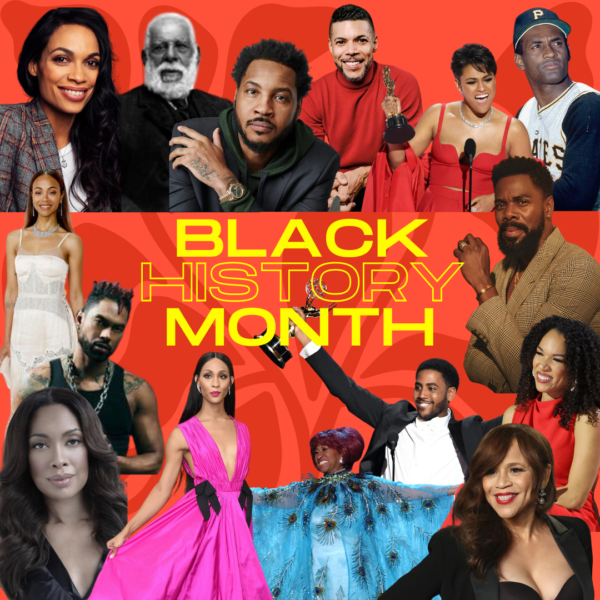
Also notably, the National Hispanic Media Coalition commemorated the start of the month by highlighting “just a few Afro-Latino visionaries, both past and present, who truly define Afro-Latino Excellence.” They listed:
- “Ariana DeBose, Academy Award-winning Actress
- “Carmelo Anthony, NBA Legend
- “Celia Cruz, the ‘Queen of Salsa’
- “Colman Domingo, 2024 Academy Award-nominee and NHMC Impact Award honoree
- “Gina Torres, NHMC Our Voice Impact Award honoree and NHMC Visionary Alliance Member
- “Jharrell Jerome, NHMC Next Generation Impact Award honoree
- “MJ Acosta-Ruiz, Bilingual On-Air Host and Reporter
- “MJ Rodriguez, NHMC Impact Award honoree
- “Miguel, Grammy Award-winner and NHMC Powerhouse Impact Award honoree
- “Pío de Jesus Pico, former Governor of the Californias and namesake of Pico Boulevard
- “Roberto Clemente, Hall of Fame Baseball Legend
- “Rosario Dawson, NHMC Impact Awards honoree and Visionary Alliance Member
- “Rosie Perez, NHMC Impact Award honoree
- “Wilson Cruz, NHMC Visionary Alliance Member
- “Zoe Saldaña, NHMC Impact Awards honoree”
- Gabby Hajduk, Chicago Bears: Bears kick off Black History Month with NABJ partnership and more
- Robin Kemp, The Current, Savannah, Ga.: Black journalists chronicle a century of trauma, resistance
- Will Sutton, NOLA.com: In Black History Month, expand your knowledge at these Louisiana sites
- Ernie Suggs, AJC: ‘Written by himself’: How slave narratives shaped modern Black literature

Press Groups Want Rwanda Death Investigated
“Rwandan authorities should allow an independent, impartial, and effective investigation, drawing on international expertise, into the death of John Williams Ntwali, a leading investigative journalist,” more than 100 civil society organizations and media associations — including the National Association of Black Journalists — said last week, Human Rights Watch reported.
“Rwanda’s international partners should press the authorities to allow and cooperate fully with such an investigation.”
The Human Rights Watch statement came just days before more than 6,000 people with ties to Rwanda gathered Sunday in and around Washington, D.C., during the 11th edition of “Rwanda Day”; the Committee to Protect Journalists expressed alarm at reports that another Rwandan journalist, Dieudonné Niyonsenga, had been tortured in prison, while Britain continued to debate while sending asylum seekers to the East African country is safe and justified.
A journalist who saw Ntwali a day before his death told Voice of America that, “He looked cautious and switched off his phone before we started talking. He said phones could not be trusted. He told me that all the doors on which he knocked were closed but he was determined to face life. His death was so sudden.”
VOA added, “Ntwali was regularly threatened and attacked in pro-government media for his investigative reporting.”
CPJ said Wednesday, “During a January 10, 2024, hearing at the court of appeal in the capital Kigali, Niyonsenga said that he was held under ‘inhumane’ conditions in a ‘hole’ and was frequently beaten, according to media reports and court documents reviewed by CPJ. Niyonsenga, who also goes by Cyuma Hassan, appeared in court with a head wound and said that his hearing and vision were impaired by the conditions of his detention, according to those sources. Niyonsenga’s lawyers also told the court that prison officials seized documents he needed to further prepare his case. . . .”
In Britain, the Conservative government “wants to send all asylum seekers who enter the UK across the Channel on small boats to Rwanda, arguing it would act as a deterrent. The supreme court last year ruled that Rwanda was unsafe,” the Guardian reported Jan. 27, leading Prime Minister Rishi Sunak to introduce new legislation which, he argues, allays those concerns.
To subscribe at no cost, please send an email to journal-isms+subscribe@groups.io and say who you are.
Facebook users: “Like” “Richard Prince’s Journal-isms” on Facebook.
Follow Richard Prince on Twitter @princeeditor
Richard Prince’s Journal-isms originates from Washington. It began in print before most of us knew what the internet was, and it would like to be referred to as a “column.” Any views expressed in the column are those of the person or organization quoted and not those of any other entity. Send tips, comments and concerns to Richard Prince at journal-isms+owner@
View previous columns (after Feb. 13, 2016).
View previous columns (before Feb. 13, 2016)
- Diversity’s Greatest Hits, 2018 (Jan. 4, 2019)
- Book Notes: Is Taking a Knee Really All That? (Dec. 20, 2018)
- Book Notes: Challenging ’45’ and Proudly Telling the Story (Dec. 18, 2018)
- Book Notes: Get Down With the Legends! (Dec. 11, 2018)
- Journalist Richard Prince w/Joe Madison (Sirius XM, April 18, 2018) (podcast)
- Richard Prince (journalist) (Wikipedia entry)
- February 2018 Podcast: Richard “Dick” Prince on the need for newsroom diversity (Gabriel Greschler, Student Press Law Center, Feb. 26, 2018)
- Diversity’s Greatest Hits, 2017 — Where Will They Take Us in the Year Ahead?
- Book Notes: Best Sellers, Uncovered Treasures, Overlooked History (Dec. 19, 2017)
- An advocate for diversity in the media is still pressing for representation, (Courtland Milloy, Washington Post, Nov. 28, 2017)
- Morgan Global Journalism Review: Journal-isms Journeys On (Aug. 31, 2017)
- Diversity’s Greatest Hits, 2016
- Book Notes: 16 Writers Dish About ‘Chelle,’ the First Lady
- Book Notes: From Coretta to Barack, and in Search of the Godfather
- Journal-isms’ Richard Prince Wants Your Ideas (FishbowlDC, Feb. 26, 2016)
- “JOURNAL-ISMS” IS LATEST TO BEAR BRUNT OF INDUSTRY’S ECONOMIC WOES (Feb. 19, 2016)
- Richard Prince with Charlayne Hunter-Gault, “PBS NewsHour,” “What stagnant diversity means for America’s newsrooms” (Dec. 15, 2015)
- Book Notes: Journalists Follow Their Passions
- Book Notes: Journalists Who Rocked Their World
- Book Notes: Hands Up! Read This!
- Book Notes: New Cosby Bio Looks Like a Best-Seller
- Journo-diversity advocate turns attention to Ezra Klein project (Erik Wemple, Washington Post, March 5, 2014)

